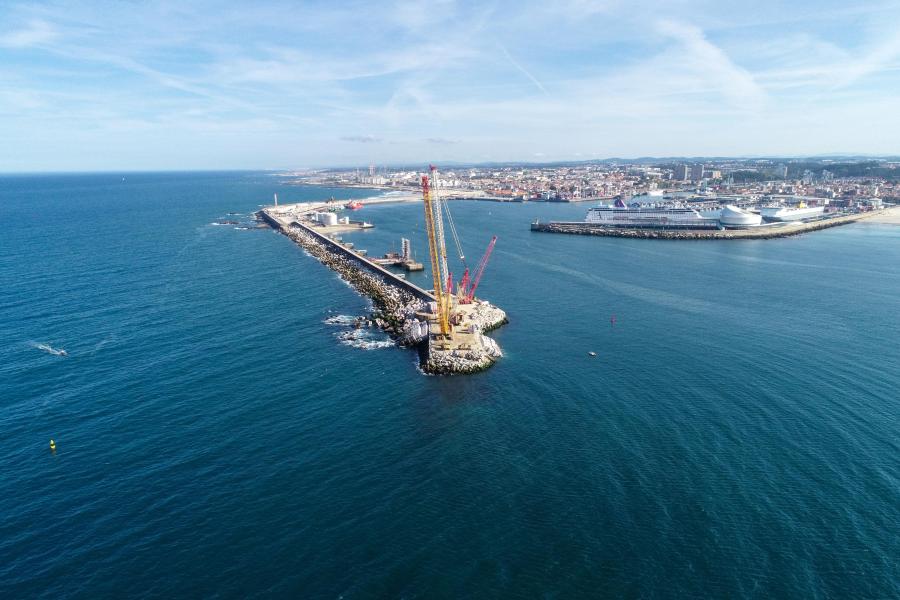
- The loan will improve maritime accessibility to the existing infrastructure, allowing larger ships to call at the port, reducing waiting times and consequently easing operational and safety restrictions.
- This support promotes economic, social and territorial cohesion, as the investments will be made in an EU convergence region in Portugal.
- The European Investment Bank has a long-standing relationship with APDL, dating back to the 1970s.
The European Investment Bank (EIB) has agreed a loan of €60 million with Administração dos Portos do Douro, Leixões e Viana Do Castelo, S.A. (APDL) to finance maritime accessibility improvements in the Port of Leixões, deepening the access channel and widening the existing breakwater.
In line with the European Union’s Trans-European Transport Network (TEN-T), this project will help ensure the efficient transport of people and goods, guarantee access to jobs and services and enable trade and economic growth. The total cost of the project will be around €190 million, with the EIB loan guaranteed by the Portuguese government.
The signing ceremony took place today, 11 September, at the Port of Leixões, and was attended by the Minister for Infrastructure, João Galamba, the Vice-President of the EIB, Ricardo Mourinho Félix, and the Chairman of APDL, João Pedro Neves, who stressed the importance of this investment in financing the modernisation and expansion of the most important port in the north-west of the Iberian Peninsula in terms of cargo and containers.
The Minister for Infrastructure, João Galamba, insisted that “the upcoming work will ensure the Port of Leixões continues to grow and reaffirm its importance to the economy in Portugal’s northern region” and noted that “the EIB has once again made clear its commitment to developing Portugal’s port infrastructure.” “This cooperation will be reinforced in the coming years, given the need to make major investments in the ports to fulfil the new strategic vision we have defined for the sector. It is also worth highlighting the investments aimed at ensuring port infrastructure can develop offshore wind projects, as well as the funding aimed at tackling the energy and digital transition,” said Galamba.
João Pedro Neves, chairman of APDL, commented that “this is the most significant investment made in the Port of Leixões in recent years and, more importantly, one of the most notable for both the northern region and Portugal as a whole. The growth potential that this investment in accessibility will foster is particularly critical for the container segment, but it will also benefit other market segments, such as dry bulk, and especially agri-food, ensuring an effective response to the needs of companies operating in the vicinity of the Port of Leixões.”
“With this investment, we are not only deepening the access channels for larger vessels, but also anchoring the roots of economic and social cohesion in the region,” said Ricardo Mourinho Félix, pointing out that the loan to the Port of Leixões is a show of support not only for Portugal’s maritime progress, but also for the common vision of an interconnected Europe.
The EIB remains committed to achieving growth and resilience across Europe’s transport infrastructure. This policy encourages sustainable and more efficient transport for people and goods, guarantees access to jobs and services and enables trade and economic growth. It also reinforces economic, social and territorial cohesion within the European Union by creating seamless cross-border transport systems with no missing links or bottlenecks.
Background information
About the EIB
The European Investment Bank (EIB) is the European Union’s long-term financing institution and is owned by the Member States. It finances sound investments that contribute to EU policy objectives.
The European Investment Bank Group (EIB Group) — comprising the European Investment Bank (EIB) and the European Investment Fund (EIF) — recorded another year of excellent results in Portugal, with €1.7 billion of total financing underwritten in 2022.
About APDL
APDL is responsible for managing the ports of Leixões and Viana do Castelo, as well as the Douro’s inland waterway. It is one of the most important companies in the country, directly influencing 6% of national GDP and employment and 11% of GDP and employment in the northern region.
To ensure the Port of Leixões remains competitive, there must be a response to the increased average size of the vessels calling at the port, up 77% between 2006 and 2018.
The project to extend the breakwater and improve maritime access to the Port of Leixões is aimed at improving safety conditions and navigability in the access to the Port of Leixões and in the ship manoeuvring area in the outer harbour.
The improvement will serve current maritime traffic, allowing for safer and easier access and manoeuvring, which in turn will improve the port’s overall operation. It will also provide the necessary conditions for access and berthing by larger cargo ships, particularly those in the 300-metre length, 40-metre beam and 13.7-metre draught class, with a capacity of around 5 000 TEU.
Aware of the challenges facing the country and the wider community, we continue to stress the strategic importance of our infrastructure to the local, regional and national economy, as a means of promoting a sustainable and ambitious vision for the territory.



